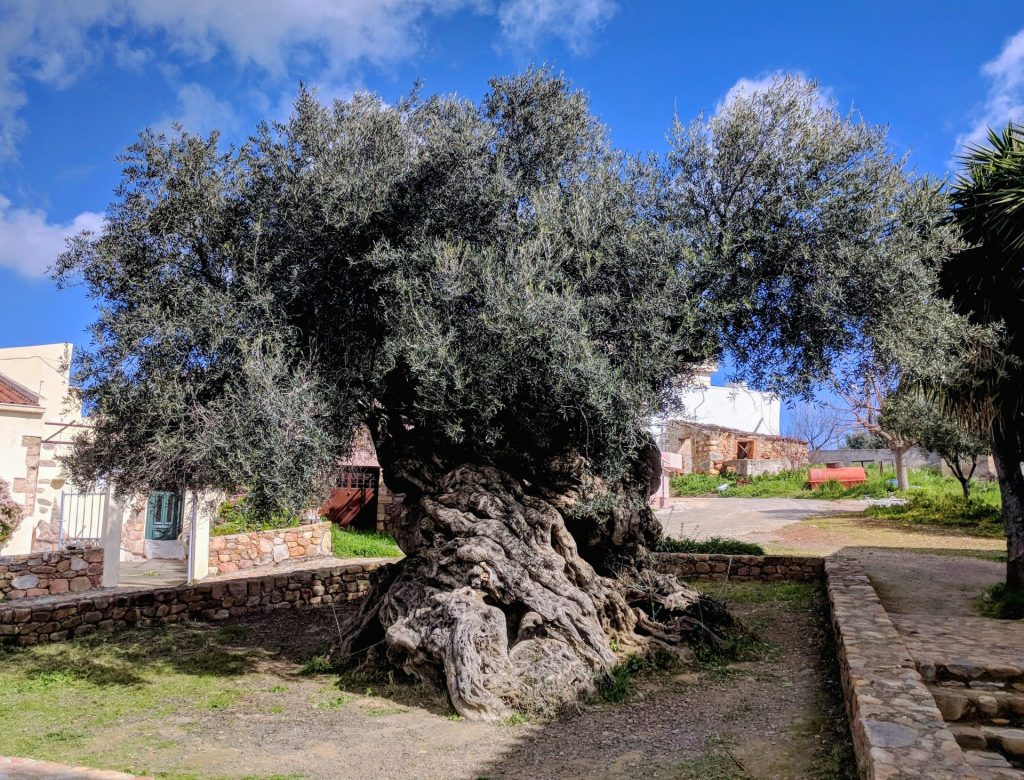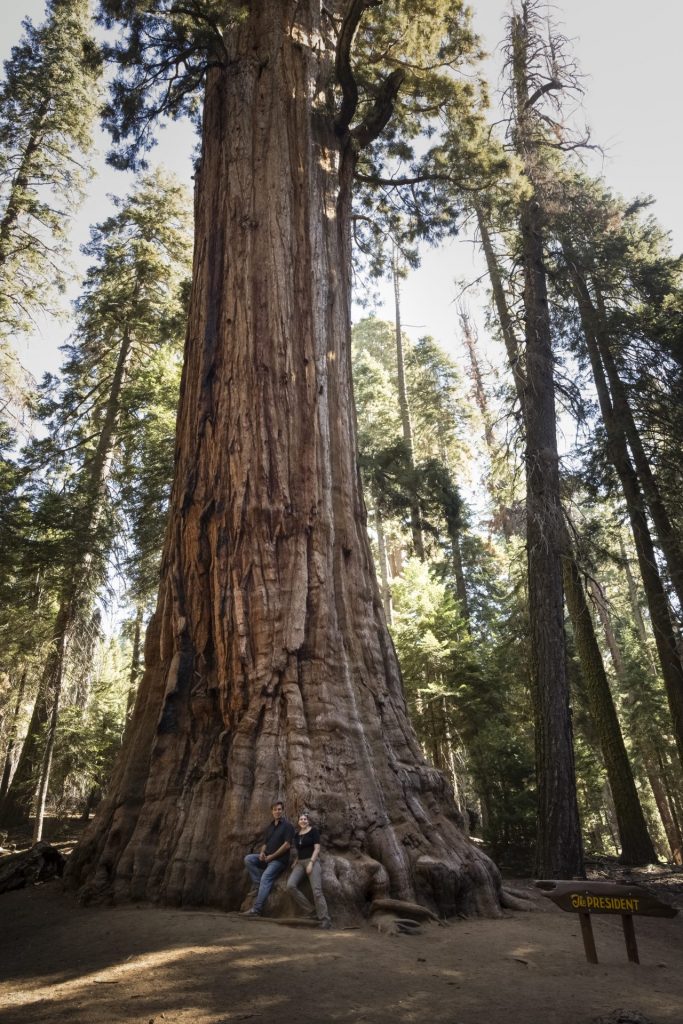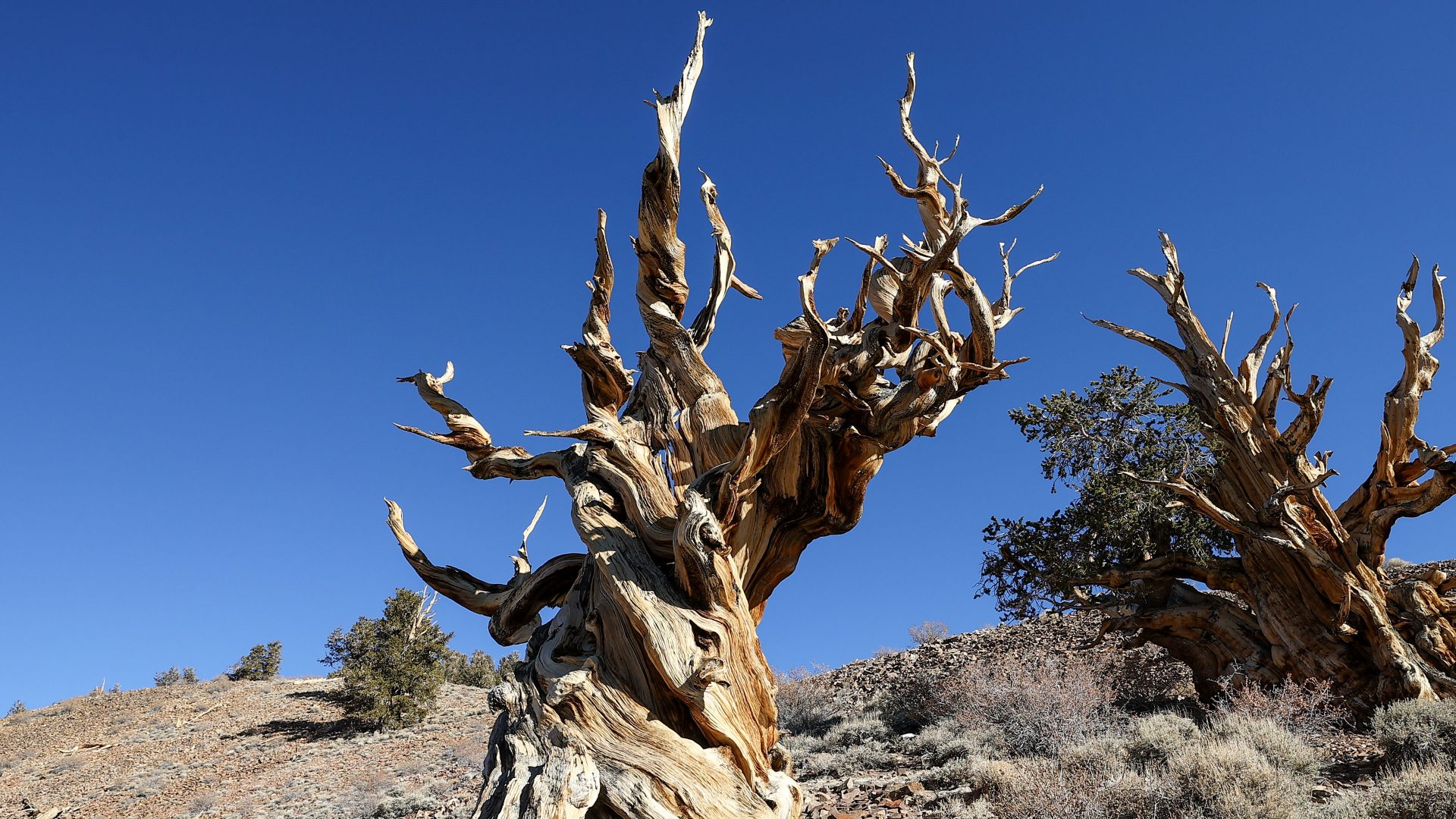Real learning is neither imposed nor pursued out of duty: it’s a primal hunger that stems from an irresistible blast of wonder. Call it the F* Me Factor. You come across something extraordinary – brilliant worldchanging. F* me! And as soon as you’ve said it you have to find out more.
The internet might have been designed to supply the world with a daily experience of the FMF. It’s also quite good at feeding the resulting hunger: you must have information, reliable if possible, but certainly now.
And there on my screen was an image of the olive tree of Ano Vouves. It’s growing on the island of Crete, it’s 12.5 metres in circumference and 4.6
metres in diameter, it’s 3,500 years old and it’s still producing olives. Very
expensive olives.
The date isn’t precise: the heartwood has gone and dating by radio isotopes
doesn’t work. Tree-ring analysis gives a minimum age of 2,000 years. Crete
University says it’s 4,000 years old. But let’s stick with 3,500: which means it
was a seedling in 1500BC, so it’s 1,000 years older than Athenian democracy.
This tree, this living thing still producing fruit, is older than the oldest building on the Acropolis. It’s older than the Ancient Egyptian temple of Abu Simbel. It’s older than I Ching, the Rigveda, the Old Testament and the Torah. It’s older than the events that inspired The Iliad and The Odyssey: it was already 300 years old when Troy was sacked.
It was an old tree when Jesus preached the Sermon on the Mount. It was gnarled and twisted with age when William the Conqueror crossed the Channel. It was already in its dotage when the Industrial Revolution began. Human understanding of time doesn’t really work when it comes to the olive tree of Ano Vouves.
The tree has its rivals. The Fortingall yew in Scotland is between 2,000 and
3,000 years old. The President, a giant sequoia in California, is 3,200. Methuselah, a Great Basin bristlecone pine in California, has an age claim
based on ring-count of 4,853 years, which makes it – perhaps – the oldest
non-cloned plant in the world.
I had the pleasure of writing the book that accompanied the David Attenborough blockbuster series The Green Planet – and there he was
standing in the Mojave Desert that straddles California and Nevada, in the
middle of a ring of straggly creosote bushes. He had stood in exactly the
same place 40 years earlier: shortly before the Falklands invasion, ET, and
Thriller. In that time the plant – for it was all one plant – had grown a total of
12mm, a finger’s width.
The plant is 11,700 years old. The same living thing has been cloning itself – throwing out genetically identical models of itself – for all that time. In other words, this clump of arid, scrubby, deeply unprepossessing life is as old as agriculture. Humans had just begun to take control of the planet when this plant – the King Clone – first germinated.
F*** me.
Such feats are – mostly – beyond us lot in the animal kingdom. Greenland
sharks have claims for 500 years. Bowhead whales have been found with
embedded harpoon tips that date from the 1890s, giving them a span – they
must have been of a decent size when they were harpooned – of a couple of
centuries.

The record for land animals is usually given to Adwaita, an Aldabra giant tortoise who lived in the zoo at Kolkata and was 256 at his death in 2006. A sulphur-crested cockatoo called Cocky Bennett reached, it’s claimed, 120. The best record for a human is Jeanne Calment of France, who died in 1997 aged 122 years and 164 days.
In evolutionary or genetic terms any lifespan that allows you to leave viable
young – to become an ancestor – is long enough; that’s why there is no evolutionary pressure to develop immunity to the diseases of old age. It’s also why some species live a bewilderingly short period of time.
Leave a patch of broken ground and life will move in at once. The first colonisers will be ephemeral plants like chickweed and groundsel: they will rise from seed, get fertilised, produce and disperse viable seeds of their own and then die, all in a matter of weeks. They can go through several generations in a year when conditions are right.
Living a short life can be just as effective, in ancestor terms, as living to be 3,500. Many insects in their adult form live only a matter of hours. Mayflies, from the family Ephemeroptera or ephemeral wings, famously live less than a day. An adult female Dolania americana lives for about five minutes – though she will have spent a year or more as an aquatic larva.
A lot of desert life is based on long waiting in an inert, apparently lifeless form, followed by frantic activity when the rare rains come. I visited the Kalahari when it was teeming with frogs. They lie inert beneath the sand for years, reviving in the rain to live a few days in the brief wet, attempting to become an ancestor before drying up. The desert soil can contain many seeds: when the rain comes the desert has a few days of floral magnificence
as their own race to become an ancestor is run at frantic pace. All must be completed before the place dries out again.
A massive lifespan is not an improvement, it’s just a different evolutionary strategy… and marine animals called glass sponges have the edge even over Attenborough’s creosote bush. They live in cold water on the ocean floor in areas high in dissolved silica. From this, over fantastic periods of time, they
construct their fantastical selves: bodies based around a structure in effect made from glass.
There is an eerie beauty about them; one species is known as Venus’s flower
basket. They are filter-feeders, taking in tiny specks of living matter from the
waters around them. Mathematical estimates based on their rate of growth give a lifespan of 23,000 years. This might be a slight exaggeration: counter-suggestions put the figure closer to 15,000 years. There are, then, living glass sponges older than the Niagara Falls.
We are mammals and all of us share furriness, milkiness, a neocortex in the brain and three middle ear bones. We also – all of us – tend to live a life of
about one billion heartbeats. That’s true for a shrew with a heart beating 1,000 times a minute, and an elephant beating at 35. Humans, with a resting
heartbeat of around 80, are outliers, because of antibiotics, other aspects of
modern medicine and care for young and for old.
So what does time feel like for a shrew? A year is a lifetime: does a week feel like a year, with so much incident and alteration? Is a mouse’s personal experience of life the same as that of a blue whale?

Certainly we humans experience time subjectively: time flies when you’re having fun, a day of boredom seems an eternity, weeks flicker past in maturity while for a child the summer holidays last for ever. Threescore and ten seems like several centuries to a teenager, but it’s a blink of an eye to those who have that figure in the rear-view mirror. It’s hard to get a handle on the real meaning of time.
Freud claimed that science has provided three great breakthroughs in human understanding: when Copernicus showed us that the earth is not the centre of the universe but a planet orbiting the sun, when Darwin made clear our ancestry, and when Freud himself (the modesty of the man!) showed that we are not the rational beings we always thought.
But he missed one. The palaeontologist and writer Stephen Jay Gould claims that the fourth great breakthrough is the discovery of Deep Time. This was first spelt out in Charles Lyell’s Principles of Geology, published in three volumes between 1830 and 1833. The biblical age of the earth is around 6,000 years: Lyell replaced this with a calendar reckoned in hundreds of millions.
This revelation of Deep Time still provides every child with one of the first and perhaps the greatest experience of the FMF: when we learn that the world was once full of dinosaurs, and they all perished 65m years ago.
Our minds are not capable of grasping time on such a scale. We struggle even to grasp the extent of human history. We fall back on metaphor: comparing, say, the history of the earth to the old measure of the English yard: the distance from the king’s nose to the tip of his outstretched hand. Gould writes: “One stroke of a nail file on his middle finger erases human history.”
But that stroke of the nail file is what we humans think of as A Very Long Time. Agriculture began in several places and more or less simultaneously about 12,000 years ago and we have been modifying the planet for our convenience ever since. It was the biggest event in human history; and it was the biggest event in the history of the world since the meteor fell in the Gulf of Mexico and wiped out the dinosaurs.
The olive tree of Ano Vouves started to grow when agriculture was old, when written cultures were beginning. We call that time the Ancient World, forgetting that the world is vastly – incomprehensibly – more ancient.
A failure to understand time was not a problem to our hunter-gatherer ancestors: short-term thinking was not only inevitable but part of our package of survival instincts. Our later farming ancestors changed that: planning ahead to the next harvest and even the one after that. We have evolved, very successfully, as short-term thinkers: and we have modified the planet for our convenience in the belief that five years is a long time.
But this short-term mindset is now getting us into trouble. We have never dwelt too long on consequences; we have always had trouble believing that
things change over time. What’s the worst that can happen? Thirty years ago climate change was widely seen as the mad fantasy of scaremongers: last week brought us record temperatures, with a great deal of Britain and the rest of Europe on fire. We are in the midst of an extinction crisis: the first since the passing of the dinosaurs. The human population continues to rise.
Some people say our current way of life is unsustainable, but they’re wrong. All we need to do is to find another couple of habitable planets.
The earth will no doubt recover from this triple crisis. After all, it recovered from the Permian extinction. This was an event involving global heating and it took place 250m years ago. It wiped out 90% of all species. The cause was volcanic; temperatures soared because heat was trapped by vast emissions of carbon dioxide and methane.
The process of recovery took 10m years, though more recent estimates are shorter. So we don’t need to worry about climate and extinction and population and the general tendency to lay waste to the planet: the earth
might well recover in as little as 3m years.
Butterflies have traditionally been used as symbols of the brevity of life. An adult butterfly will live only a few days, though of course it spends longer as a caterpillar. (Some species over-winter as adults in an inert form.) But despite the brevity of their lives, painted lady butterflies migrate to Britain after a journey of 12,000km from north Africa. They travel not as individuals but as a succession of about six generations.
If humans are to escape the mayhem we have created on our home planet we must model ourselves on these butterflies. If we are to travel beyond the
solar system we must be like painted ladies – and travel through generations
to places that are beyond the reach of an individual life. It’s about changing our understanding of time. We think that a week is a long time in politics: we need to realise that in terms of real time – time as the earth knows it – the olive tree of Ano Vouves has lived fast and will die young.




